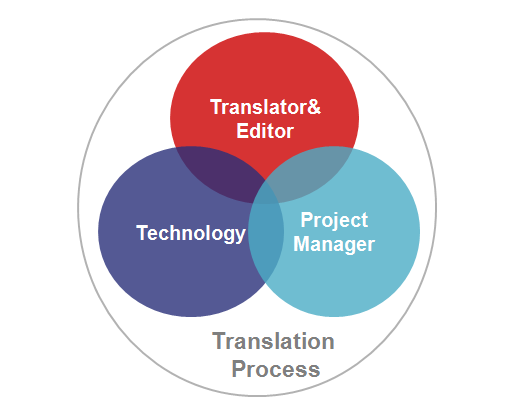Life sciences translations: Critical success factors
Within the life sciences industry, ensuring the highest quality of a translation can’t be underestimated. To minimize even the remotest possibility of a mistranslation, every component of the translation process needs to be optimized.
Translation quality depends on four components:
- Translators and editors
- Project manager
- Technology
- Process
Translators and editors
At the core of quality is accuracy. Critical to accuracy is to have a fully trained native speaker of the target language with near-native knowledge of the source language. Any deviation from this requirement exposes the translation to unnecessary and possibly significant errors. The source of mistranslation is typically caused by lack of training (translating words rather than meaning, improper use of translation tools, inadequate research skills, lack of reference material, etc.). For highly technical material, the translator should have advanced academic credentials to ensure industry-specific vocabulary is interpreted and translated correctly.
Just as writers are incapable of objectively separating themselves from their work, translators face the same dilemma. For this reason, editors – having equal skill as translators – provide objectivity and a fresh perspective.
Finally, you should alway try to use the more experienced translator and editor pairs, rather than those who have little to no experience.
Project manager
There are three general components to the role of a project manager (PM): client relations management, file management and resource coordination.
Client relations management is critical because the PM is on the receiving end of the client’s project requirements. They can provide reference materials, project orientation, and feedback (before, during and after a project). A PM who recognizes the importance that their role plays in the overall success of the project will facilitate a better product, whether it be a website, video presentation or interpretation assignment. In fact, language service providers (LSPs) that specifically train their PMs in client relations management are more inclined to have better client satisfaction ratings and successful project outcomes overall.
Within the life sciences area, the product life cycle can be summarized by the following stages and related documentation:
Different types of files are treated differently. In the translation industry there are two important file features: accessibility to text and layout. Every file, whether a scanned PDF, Adobe Indesign file or XML file, has its own level of text access and layout considerations; and with them, different requirements and treatment.
Content for translation can vary broadly. By coordinating content with a translator’s and editor’s specialization, fewer problems occur, which equates to a lower probability of errors during the translation process.
Technology
Technology allows for the source files to be handled quickly and inexpensively. Specifically, technology such as rapid text extraction tools and translation memory allow for significant time savings and higher translation quality.
- Rapid text extraction tools: Allows source text to be extracted and replaced with target language text, without impacting anything else in the files such as font and paragraph characteristics, object location, etc. – saving considerable time.
- Translation memory: Ensures language consistency within and between files by automatically translating identical sentences and terms wherever located – reducing translation time and improving translation quality.
Process
As standalone entities, translators, editors and technology contribute only fractions of the quality demanded by the industry. The ensemble of the components, coordinated by a trained and experienced PM, is what provides for a high quality translation process. 
Since translators, editors and project managers are people, this process is prone to human error. Therefore, the ideal translation process needs to be designed specifically to mitigate the risk of errors. If designed properly, implementing the ISO 9001:2015 standard ensures consistency and continual improvement. However, even with an ISO process in place, translation errors may still occur. Only after years of constant monitoring and correcting will an ISO process consistently produce high quality translation deliverables with a miniscule number of errors per year.
Summary
The critical success factors of life science translations are specialized translators and editors, experienced PMs, advanced translation technology and proven ISO processes to manage everything. A quick and comparable measure of quality for the process, as a whole, is the % errors per project. Be sure to choose an LSP that has high ratings on all factors and a low average error percentage to avoid serious mistranslations that could result in big financial consequences.
If you’d like to learn more about how BURG Translations helps you ensure high quality translations, contact us today.




